By Brandon Fey, Assistant News Editor
2024 marks a major milestone in the memory of the Second World War. This year is the 80th anniversary of D-Day, when the Allied powers invaded the Normandy beaches of occupied France on June 6, 1944. In celebration of this meaningful legacy, the Eisenhower Institute at Gettysburg College and the Dwight D. Eisenhower Society co-sponsored the D-Day 80+ Symposium on April 20.
The program began with a welcome and introduction from Executive Director of the Eisenhower Institute Tracie Potts, who emphasized the institute’s commitment to upholding the legacy of World War II and the role played by General Dwight Eisenhower as Supreme Leader of Allied Forces.
Potts was followed by Executive Director of the Dwight D. Eisenhower Society Carol Hegeman, who offered a specific thanks to the event’s many sponsors including the Robert M. Lauman Charitable Foundation, the World War II American Experience Museum, Destination Gettysburg, the Eisenhower National Historic Site, the World War II Foundation and the Federal Pointe Inn.
The first event was a presentation titled “The Americans at D-Day,” given by Curators’ Distinguished Professor of U.S. Military History at the Missouri University of Science and Technology Dr. John C. McManus.
In his lecture, McManus spoke about the D-Day invasion as a team effort among cooperating Allied nations that also marked the first time the United States took a significant leading role in an international operation. He contextualized the difficulty of many of Eisenhower’s leading decisions while planning the operation, citing the necessity of a bombing campaign he authorized that resulted in the unfortunate killing of thousands of French and Belgian civilians before the invasion. He also spoke of the conflicting opinions held between Eisenhower’s British and American advisors, which he as Supreme Allied Commander had to consider while also upholding impartiality, given his nationality as an American.
McManus then mentioned personal anecdotes of those involved in land, sea, and air components of the operation. Each story emphasized the adaptability and determination of the common soldier, sailor and airman who succeeded in overcoming a myriad of unplanned obstacles to achieve victory.
Concluding his segment, McManus stated, “If we’re looking at D-Day American historians, it’s the beginning of the end of World War Two in Europe. But it’s also the beginning of a new internationalist, militarily powerful world-leading U.S., committed to shedding its own blood for the security of Europe.”
The next event was titled “Perspectives on D-Day Panel Discussion” which featured a panel moderated by Professor of History at Gettysburg College Dr. Michael Birkner.
The first panelist was Chairman Emerita at the Eisenhower Institute Susan Eisenhower, whose talk was titled “Early Planning for Operation Overlord; Important but Little Remembered Leadership Decisions.” She began by discussing General Eisenhower’s leadership during World War II, emphasizing the necessity of integrating multinational Allied perspectives while maintaining a coherent strategic approach. These principles applied to each of his strategic decisions including resource allocation.
According to Eisenhower, her grandfather was able to make his difficult decisions as he was guided by a sense of duty to the greater good without a care for his remembrance in history, citing his reflections in his personal journals.
Discussing General Eisenhower’s diary entries, she said, “He muses about what he called the ‘short-sightedness’ of the average human and their care about promoting their intense personal outlook that most officers have… many times he went on to say that his principle effort was going to do its duty no matter where it led. And in doing so, he would be meeting a higher calling, which was to serve something larger than himself.”
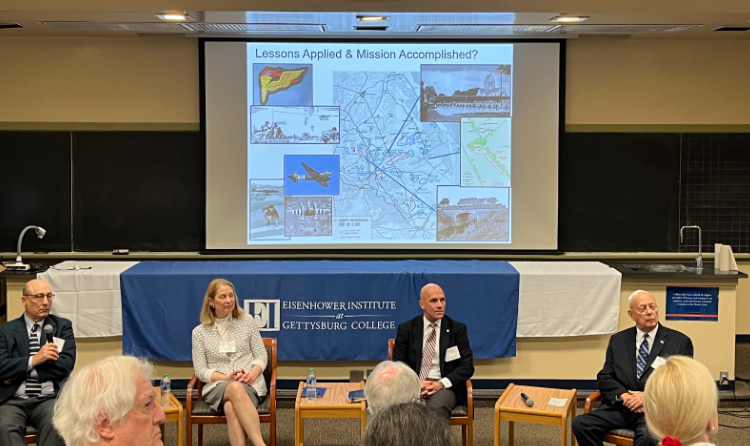
L-R: Dr. Birkner, Susan Eisenhower, Dr. Douds, and General Matz answer questions for their panel. (Photo Brandon Fey/The Gettysburgian)
In any case, the effort to bring all those together underscored in a way one of the biggest problems Eisenhower faced, and that was that the United States was becoming ascendant over its founding country, and Britain was beginning to lose a grip on his empire and the war This is one of the subjects for the war.
The next panelist was Colonel Dr. Doug Douds, Ret. His presentation, titled “Operational Dilemma; The German Defense of Normandy,” provided a picture of D-Day from the often under-considered German perspective. He focused on the strategic differences between German Fieldmarshals Gerd Von Rhundstedt and Erwin Rommel in light of the greater lack of coordination among the leaders of the German high command that was responsible for a lack of sufficient air and naval presence in defense against the invasion.
Douds also spoke on the lesser-mentioned Osttruppen, who were soldiers from Eastern Europe pressed into the ranks of the German military. These soldiers, he explained, defended the beaches with a particular zeal, as they knew that an Axis victory was the hope for them lest they faced execution upon returning to the Soviet-occupied east.
The final panelist was Major General William Matz Jr., Ret. whose talk was titled “Allied Airborne Operations in Normandy on D-Day, 6 June 1944.” The general spoke about the parachute and glider landings that took place the night before the invasion of the beaches. He explained the immense challenge the airborne soldiers faced, as heavy anti-aircraft defenses compelled pilots to find alternative drop locations than those that were originally planned. Matz highlighted the ingenuity of the soldiers and airmen, who, despite being prevented from landing at their intended locations, managed to regroup upon landing and make their way to the nearest objectives.
The symposium then took a brief intermission for audience members to have a lunch catered by Gettysburg College Dining Services in the Atrium of the Dining Center. They were greeted by an authentic Willys MB jeep from the Second World War that was parked outside of the Atrium.
Following lunch, the program resumed with a presentation by Professor Emeritus of the U.S. Naval Academy Dr. Craig L. Symonds. His lecture, titled “‘The Navy Saved Our Hides’: U.S. Naval Gunfire Support on D-Day,” quoted a remark made by American General Omar Bradley shortly after the success of the operation. Symonds focused on the indispensable role that the Allied navies had in supporting the D-Day invasion. He discussed how naval artillery was used to soften German fortifications above the beaches, allowing ground forces to advance.
His presentation specifically addressed the improvised coordination between soldiers and sailors in directing artillery to the camouflaged German defenses as a majority of the radio sets that were taken onto the beach became waterlogged or destroyed. One example included sailors observing the direction of American tank barrels to infer the location of targets on the shore. Symonds emphasized the courage of those involved, as several destroyer ships came close to beaching themselves as they crossed the beaches to deliver direct fire at a close range.
The final presentation was given by Director of the Institute for Public Service David Eisenhower.
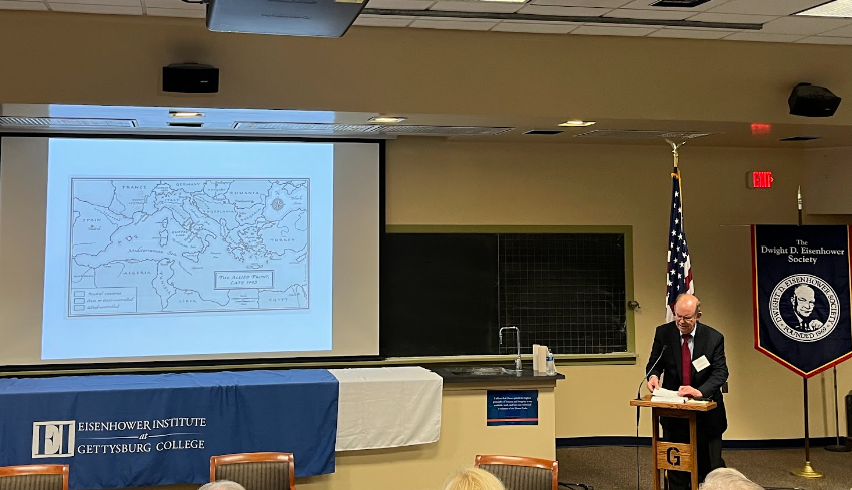
David Eisenhower delivers the final presentation of the symposium. (Photo Brandon Fey/The Gettysburgian)
His talk, titled “Triumph and Tragedy — D-Day and Beyond,” focused on how the strategic components of D-Day carried on into the rest of the Second World War and beyond.
He began with a discussion of the Tehran Conference of 1943, during which President Franklin D. Roosevelt, Prime Minister Winston Churchill, and Soviet leader Joseph Stalin conferred to develop a common strategy and begin post-war planning. He connected this to General Eisenhower’s role in planning the D-Day invasion and united the participants with his clarity of purpose and profound drive to succeed, which he maintained throughout the remainder of the war. He then reflected on the American role in leading the West through the Cold War, and how Eisenhower’s example of dynamic cooperation was carried on in deterrence against the Soviet Union.
“What happens between 1944 and 45 makes it predictable and inevitable that the United States assumed the preeminent position that we did assume in the post-war. All this unfolds at the Tehran Conference” he said.
The Symposium concluded with a final expression of thanks from Potts and Hegeman. Following the program, the speakers held a book signing in the lobby of Masters Hall. Attendees were then offered optional activities that included a guided tour of the D-Day casualties buried in the Gettysburg National Cemetery and the screening of the film “D-Day at Pointe Du Hoc,” which was introduced by WWII Foundation CEO Colonel John Fenzel, Ret.

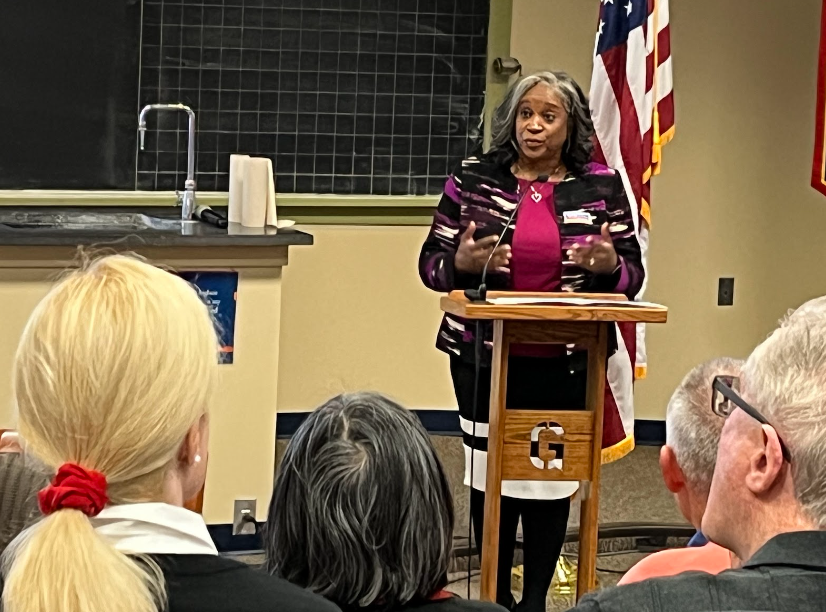
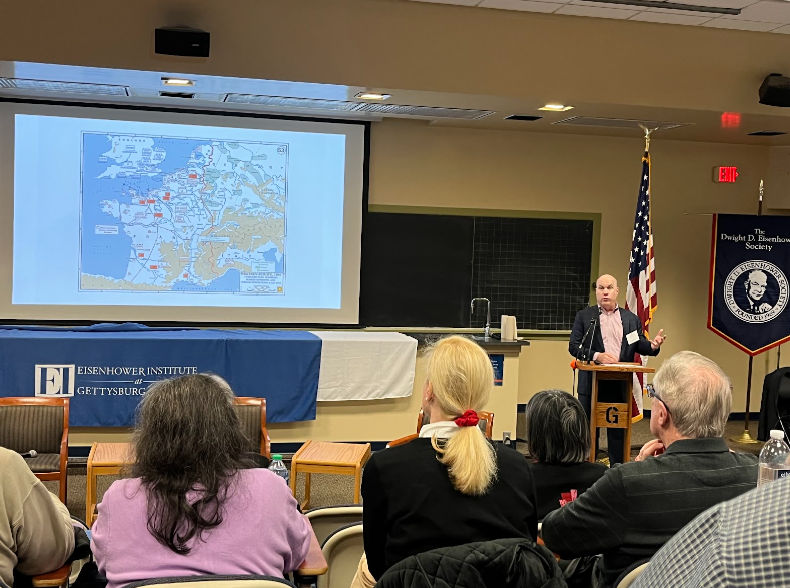
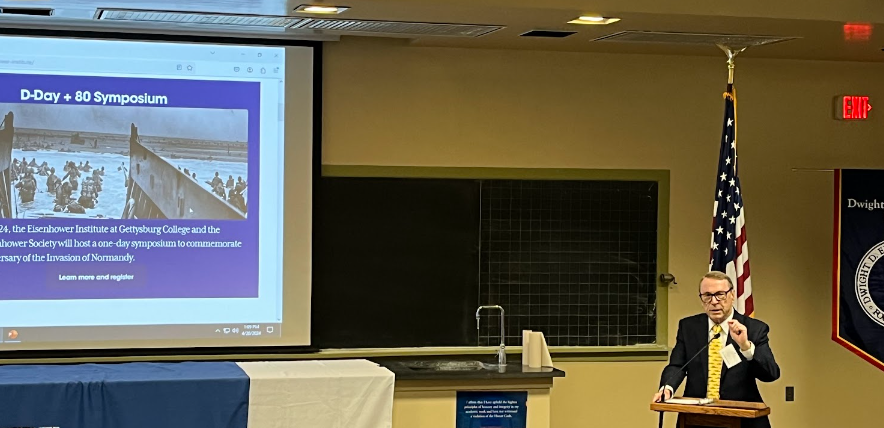
April 24, 2024
This is superior report on what was a superb symposium. Congrats to all who planned and participated ‼️